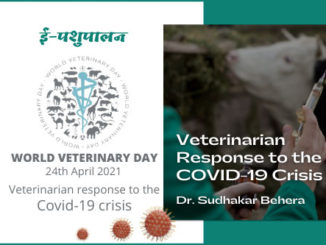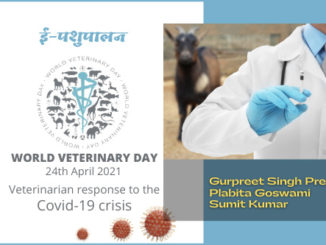On December 12th 2019, the causative agent (corona virus) was identified as a member of Coronaviridae family and on January 12th 2020 this fast-spreading virus designated as “2019-novel coronavirus (2019-nCoV)” by the World Health Organization (WHO) and on February 11th 2020 Novel Coronaviral Pneumonia and CoV-associated diseases were referred to as “COVID-19” by WHO. Later, Coronavirus Study Group (CSG) of the International Committee on Taxonomy of Viruses (ICTV) designated this emerging virus was as “SARS-CoV-2”. On March 11, 2020 the WHO declared the situation as a pandemic which is threatening mankind to a great extent. COVID-19 is a large single stranded RNA virus of about 30,000 base pairs belonging to Coronaviridae family. The virus first reported from Wuhan, China affecting more than 200 countries throughout the world. Its genome has 77.5% resemblance to the SARS but 96% resemblance to one of strain found in bats. It is a large family of viruses that range from the common cold to Middle East Respiratory Syndrome (MERS). Approx. 20 percent of colds are the result of a human coronavirus. Animal species have their own coronaviruses that cause a variety of illnesses. The dog, cat, pig, and cattle coronaviruses are very common and do not cause illness in people. SARS-CoV-2, the virus responsible for COVID-19, originated from wild animals (likely bats) in China. This virus is highly mutagenic and contagious in nature due to mutations that created a new virus and have ability to infect humans and spread efficiently from person to person. A few animals that are living with COVID-19 patients like dogs and cats have tested positive for the presence of virus. Some coronaviruses cause cold-like illnesses in people, while others cause illness in certain types of animals, such as cattle, camels, and bats. Some coronaviruses, such as canine and feline coronaviruses, infect only animals and do not infect humans.
The COVID-19 outbreak once again proves the potential of the animal-human interface to act as the primary source of emerging zoonotic diseases. At this time, there is no evidence that animals play a significant role in spreading the virus that causes COVID-19 therefore the risk of animals spreading COVID-19 to people is considered to be low. More studies are needed to understand if and how different animals could be affected by COVID-19. The virus have 4 genus alpha, beta , gamma and delta coronavirus. Various human affections are caused by alpha &beta strains like severe acute respiratory syndrome(SARS), middle east respiratory syndrome (MERS) & COVID-19. Pigs are affected by alpha and delta strains, poultry by gamma strains of coronavirus where as bovines are affected by beta strains. Bats are reservoir of alpha & beta virus whereas birds act as reservoir of gamma & delta coronavirus.
Some facts about COVID-19 in relation to animal’s role
- We do not know the exact source of the current outbreak of COVID-19, but we know that it originally came from an animal, likely a bat.
- There is no evidence that animals play a significant role in spreading the virus that causes COVID-19.
- Based on the limited information available to date, the risk of animals spreading COVID-19 to people is considered to be low.
- More studies still to be conducted to understand if and how different animals could be affected by COVID-19.
- Covid -19 positive cases have been recently reported in cats, dogs lion and tigers. It might be due to transmitted by corona positive human being
- We are still learning about this virus, but it appears that it can spread from people to animals in some situations.
- There is different type of scientific opinion in terms of susceptibility of animal covid -19. Cats, lion & tiger are more prone to covid-19 (SARS COV-2) affections than dogs, but no cases in bovine & pigs have been reported till date. Livestock are not directly associated with present Covid -19.
Impact of COVID-19 on animal husbandry
The global animal husbandry industry has been largely impacted by the effect of coronavirus. There has been a sharp fall in the demand for chicken and meat since the outbreak as there have been various rumors amongst the peoples that the virus can spread through the animal’s meat and chicken. However, the Centers for Disease Control & Prevention declared that coronavirus is known to be transmitted via direct contacts to humans, and not via livestock or aqua animals. Several government organizations have set guidelines in order to prevent the pandemic. The primary factors that were responsible for the sector growth before the pandemic were the increased consumption of meat, beef, chicken and other kinds of seafood such as prawns globally. Changing lifestyles of the peoples along with the preferences towards the luxury food items were also the prime factors for the market growth. Animal husbandry industry is segmented by type into dairy, meat, poultry, aquaculture, and others (insects). Meat and poultry are expected to get affected significantly due to the COVID-19 pandemic. Based on the regional viewpoint, the most affected regions are the US, China, Italy, France, Germany, Spain, UK, and India. The regional demand for chicken and meat is decreased due to the increased rate of virus spread. Further, it has also been witnessed that the peoples are opting for the jackfruit as the replacement of chicken and mutton. Whereas, the shutdowns of the food chain services including restaurants has also affected the market growth.
Countries are announcing several relief packages in order to reduce the impact of coronavirus in the sector as well as the rumors with it. For instance, in India, the government has set up the COVID-19 Economic Response Task Force to assess the impact of COVID-19 in the various sectors including animal husbandry. A Chicken Fair in Uttar Pradesh state organized by the Poultry Farm Association of India to dispel the rumors that COVID-19 spreads by consumption of chicken. Animal products like meat, milk & eggs are free from the corona virus however proper care, hygiene and social distancing norms should be followed while purchasing and selling of any food items.
Laboratory diagnosis of COVID-19
Respiratory tract specimens from the nasal turbinate, soft palate, and tonsils are preferred and similar laboratory diagnosis of SARS-CoV-2 is conducted in animals like in human. In situations where direct sampling is not possible due to risks to the animal or testing staff rectal swabs may also be used. PCR and RT-PCR are most sensitive method for detection of this RNA virus the real-time Reverse-transcription polymerase chain reaction (RT-PCR), is the standard and widely used method to diagnose SARS-CoV-2 in animals using the above-mentioned samples. ELISA, Rapid immunochromatographic tests and other serological assay and virus neutralization tests can be also used for the detection of antibodies against SARS-CoV-2 in animals.
Prevention and control
Till date there is no known effective treatment for COVID-19 so far although many vaccines and antiviral drugs are being tested. Main focus is to stop human-to-human spread which is an effective prevention and control strategy. Which includes personal protection (like personnel hygiene, wearing a facemask), social distancing, temperature screening, early testing, quarantine of peoples of suspected or infected individuals’ travel history, and preventing further global spread. As according to some studies origin of the virus is connected to a seafood market in Wuhan, another means for prevention and control of viral spread is identification and reduction of transmission from the susceptible animal sources. To prevent animal-to-animal spread in animals that belong to owners infected with SARS-CoV-2 they should be kept indoors in line with similar lockdown recommendations for humans. One-health approach should be followed by overall countries in their prevention and control strategy to protect humans and animals, this approach can have a positive impact on prevention and control as well as consecutively in the economy.
Conclusion and future perspective
Taking the rapid spread of COVID-19 across the globe into account, the latest updates about SARS-CoV-2 with special emphasis on the role of pets and other animals on disease transmission, which will have implications for prevention and control of the disease. Animals could play an important role in SARS-CoV-2 disease transmission. In the current SARS-CoV-2 pandemic, the situation is rapidly evolving and in light of the recent evidence, we should be aware of the possibility that humans can be potentially infected with COVID-19 by animals, including pets or other. Along with other successful management of the pandemic, it is very critical to conduct further studies on the overall zoonotic risks of SARS-CoV-2 and on the possible intermediate host to prevent the re-emergence of the virus. Furthermore, it is recommend all, to enhance their strategy for animal epidemic prevention and control.







Be the first to comment